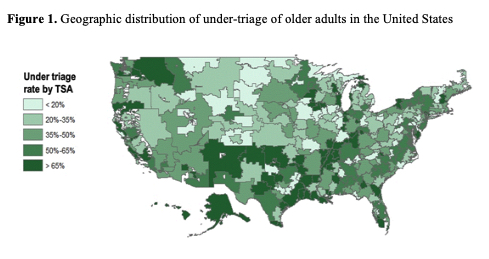Under-triage of Severely Injured Older Adults: Do system-level factors explain it?
*Manuel Castillo-Angeles1, *Tarsicio Uribe-Leitz1, *Daniel Sturgeon1, *Craig D Newgard2, *Zara Cooper1, Ali Salim1, *Molly P Jarman1
1Brigham and Women's Hospital, Boston, MA;2Oregon Health & Science University, Portland, OR
Objective: Over half of significantly injured older adults are under-triaged to lower trauma centers (TCs) or non-TCs in the US. We sought to assess under-triage patterns across the US and identify system-level factors contributing to under-triage.
Design: Retrospective analysis of the Medicare inpatient Claims file (2014-2015).
Setting: Medicare claims from more than 45 million beneficiaries.
Patients: All patients age ≥ 65 with inpatient or emergency department encounters for traumatic injury and an injury severity score ≥ 16.
Interventions: Patients were classified as under-triaged if they did not receive definitive treatment at a Level I/II TC. Incidence of traumatic injury and under-triage were aggregated to the trauma service area (TSA) level based on the Pittsburgh Atlas and linked with TSA characteristics from the Census Bureau and the American Hospital Association.
Main Outcome Measures: Odds of under-triage by TSA characteristics.
Results: We identified 55,204 patients, 38.11% were classified as under-triaged. Odds of under-triage decreased by 31% for every 1-unit increase in the number of Level I/II TCs at the TSA level (OR: 0.69, 95%CI: 0.59-0.81), and by 49% for every $10,000 increase in median income (OR: 0.51, 95%CI: 0.27-0.95). TSA-level factors accounted for 70.8% of variation in odds of under-triage. Figure 1 illustrates the geographic distribution of under-triage by TSA.
Conclusions: There is substantial variation among under-triage for injured older adults across the US. System-level factors account for most of this variation. Current interventions focus on EMS assessment for triage, but the capacity of the trauma systems should be considered. 
Back to 2020 Abstracts
